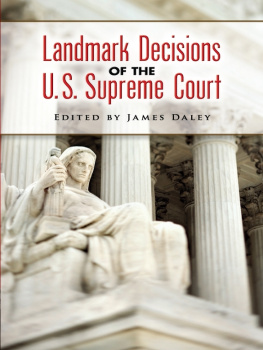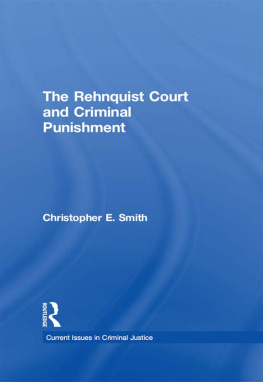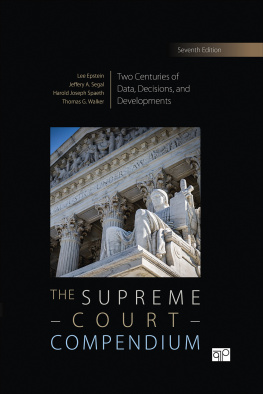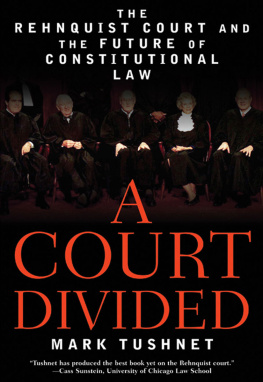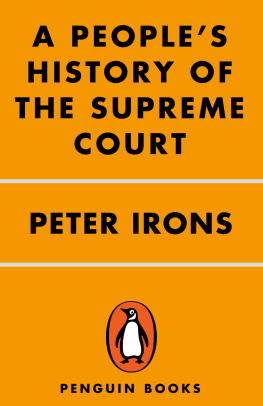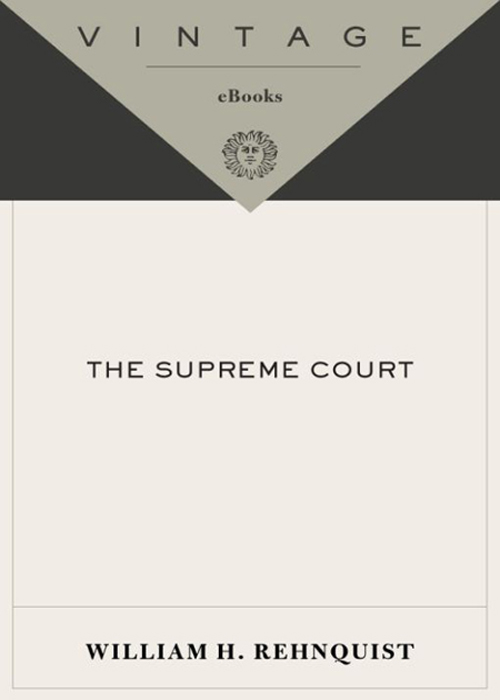
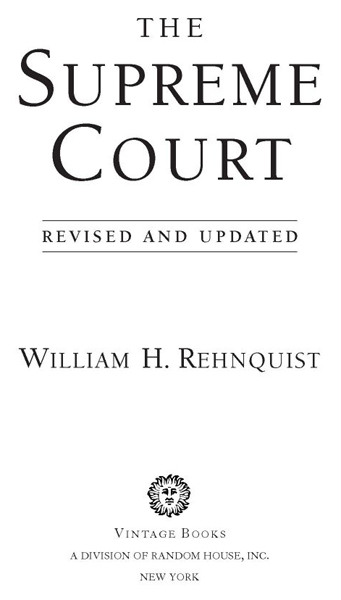
Table of Contents
To Nan
Preface
ALEXANDER HAMILTON, writing in No. 78 of The Federalist Papers, described the Supreme Court of the United States as the least dangerous of the three branches of the federal government. Whether or not the passage of time has proved this assessment correct, it has most assuredly proved that the Supreme Court is the least understood of the three branches. This book is designed to convey to the interested, informed layman, as well as to lawyers who do not specialize in constitutional law, a better understanding of the role of the Supreme Court in American government.
Most of us have been exposed in either high school or college to a descriptive summary of the place of the Supreme Court in our system of government, but it is quite evident that this is not enough to convey any but the most rudimentary understanding of the nature of the Courts work. There are literally dozens of works dealing with one or more aspects of constitutional law, but almost all of them are written for lawyers and are too detailed and too technical to be easily understood by a nonlawyer. There are excellent biographical studies of some of the justices, and the volumes in the Holmes Devise History of the Supreme Court treat the subject comprehensively. But these volumes are intended for the serious scholar and not the interested citizen trying to find out more about how the government works.
I have tried in this book to fill what seems to be a hiatus between the descriptive material and texts in American government and the comprehensive historical works. I have been guided by the view that placing the work of the Court in the context of American history, and sketching the lives and personalities of some of the most influential justices, would be more apt to whet the readers interest than would a purely abstract exposition of the constitutional doctrine expounded by the Court. The prologue, dealing with the first few months of my service as a clerk for Justice Robert H. Jackson in 1952, is designed to give the reader some feel for what the Court building is like physically, what it is like to work in that building, and the sort of work that law clerks do. The main body of the book deals with the history of the Court from the time of John Marshall to the latter part of the twentieth century; it is an effort to follow a trail on the borderland between history and constitutional law, and to give some idea of how the Courtand prominent individual justices who played crucial roles in shaping the Courts directionhave responded to important historical developments. I have tried to briefly portray the lives of some of these important justices, because the individuals who comprise the Court at any particular time have a great deal to say about the kind of decisions that the Court makes. The last section of the book is a description, from the point of view of a member of the Court, of how the Court today goes about its business of deciding cases.
To say that I have not attempted a treatise on constitutional law is an understatement. Several dozen cases at most are discussed, and whole areas of very important constitutional doctrine are not even touched upon. I have quite deliberately ended my discussion of the substantive doctrines developed by the Court with the Chief Justiceship of Earl Warren, because I wanted to avoid any discussion of the cases and doctrines in which any of my present colleagues have played a part. I have been quite willing to sacrifice completeness in my treatment of all of these subjects in the interest of putting together within manageable limits a synthesis which I hope will leave the reader feeling that he knows considerably more about the Supreme Court when he puts the book down than he did when he picked it up.
The first edition of this book went to press fourteen years ago, and was dedicated to my late wife, Nan. In the preface to that edition I said:
My wife, Nan, has been a true factotum throughout the preparation of the book. She has always encouraged me to go ahead with it, even though it meant more of my time spent in my study and less with her and the family. She has been the editor of first resort, and nearly every chapter bears the imprint of one or more suggestions which she made. When I have thought of the interested, informed, nonlawyer for whom I am writing, I have had her in mind.
I likewise dedicate this new edition to her.
My daughter, Nancy Spears, has provided invaluable help in the preparation of this revised edition. She has not only skillfully edited the two new chapters in the book, The New Deal Court and The Warren Court, but gone over the entire text with a view to suggesting necessary changes. She says her aim is to make me sound less like a lawyer, and I hope she has succeeded. My editor at Alfred Knopf, Pat Hass, has a passion for tightening sentences, and the book has benefited from her suggestions along this line.
My secretaries, Janet Tramonte and Laverne Frayer, have typed the new material in this edition, and my aide, Joe Mullaney, has also assisted me. The staff of the Library of the Supreme Court of the United States, headed by Librarian Shelley Dowling, has been more than cooperative in filling my requests for a number of volumes. Gail Galloway and her staff in the Office of the Curator of the Supreme Court have also rendered valuable help in obtaining and selecting additional pictures for the revised volume.
INTRODUCTION
A Law Clerk Comes to Washington
ON THE MORNING of January 30, 1952, in Wooster, Ohio, I was en route from my parents home in Milwaukee, Wisconsin, to Washington, D.C., where I was due in two days to report for duty as a law clerk to Robert H. Jackson, one of the eight associate justices of the Supreme Court of the United States. It was a highly prized position; I was surprised to have been chosen for it, and I certainly did not want to be late.
I had spent the night in a tourist home, where, despite the inflation resulting from the Korean War, one could still get a room for four dollars. But as I read the weather forecast, my concern grew about the remaining part of my trip. It had been snowing farther south in Ohio, and that storm was expected to move eastward across the Appalachians. Since my transportation for this trip was a 1941 Studebaker Champion, a good little car but eleven years old, I decided that I had better hurry. Driving through the Great Lakes states in the middle of winter, I had become keenly aware of a seasonal shortcoming of my car. It had no heater. As I look back, its hard to believe that even in 1941 a heater would have been optional equipment on a car sold in Milwaukee, Wisconsin. But I knew from occasionally bitter memory that I did not want to be on the road after sundown if I could avoid it.
From the looks of the sky to the southeast, I appeared to be heading into the storm. The drive from Wisconsin to northern Ohio had been familiar because I had gone to school for a short time in Ohio before entering the Army, and had been stationed there while in the service. But from here on I would be covering new territory: through eastern Ohio to Wheeling, West Virginia, and across the northern panhandle of West Virginia, through southwestern Pennsylvania, and then southeastward through Maryland to Washington, D.C. I patted my small blue Studebakers fender and thought, Dont let me down, baby. I started it up and headed toward New Philadelphia and Wheeling.
Next page

